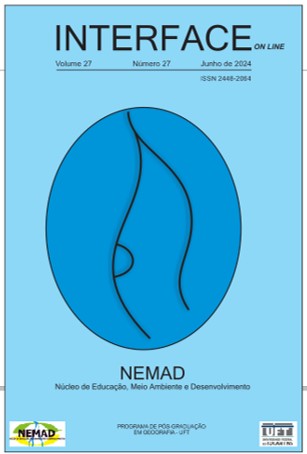LATE HOLOCENE VEGETATION HISTORY AND ENVIRONMENTAL CHANGES FROM A SAVANNA – FOREST ECOTONE ZONE IN THE BANANAL ISLAND, BRAZIL
DOI:
https://doi.org/10.20873/interface.v27i27.16330Resumo
A sediment core taken from Quatro Veados lake located in a savanna-forest ecotone area in the Bananal Island (Brazil), allowed through palynological and AMS-radiocarbon analyses to reconstruct the local vegetation history and environmental changes during the last two thousands of years. From 2190 to 1470 years BP the forest types including Bambusa, Cecropia, Moraceae/Urticaceae, Sebastiana, Rubiaceae, Sloanea and Melastomataceae/Combretaceae settled the lake margins. Savanna vegetation dominated by Poaceae and marsh/lacustrine types dominated by Cyperaceae, Eichhornia and Sagittaria were less important. Between 1470 and 590 years BP the vegetation was marked by forest retreating events occurring simultaneously with peaks of marsh/lacustrine elements, indicating increase of the flooded area and/or upper lake water level. After 590 years BP until nowadays the forest maintained stable until reduces in the present day. On the other hand, the marsh/lacustrine types increased indicating higher lake water level. This palynological record revealed that climate conditions were wet similarly to present day and oscillation between periods of longer and shorter rainy seasons and duration of flooding events governed the vegetational dynamic due to increase or decrease of the lake water level or waterlogged soils.
Downloads
Publicado
Como Citar
Edição
Seção
Licença

Este trabalho está licenciado sob uma licença Creative Commons Attribution-NonCommercial-ShareAlike 4.0 International License.
Autores que publicam nesta revista concordam com os seguintes termos:Autores mantém os direitos autorais e concedem à revista o direito de primeira publicação, com o trabalho simultaneamente licenciado sob a Creative Commons Attribution License que permitindo o compartilhamento do trabalho com reconhecimento da autoria do trabalho e publicação inicial nesta revista.
Autores têm autorização para assumir contratos adicionais separadamente, para distribuição não-exclusiva da versão do trabalho publicada nesta revista (ex.: publicar em repositório institucional ou como capítulo de livro), com reconhecimento de autoria e publicação inicial nesta revista.
Autores têm permissão e são estimulados a publicar e distribuir seu trabalho online (ex.: em repositórios institucionais ou na sua página pessoal) a qualquer ponto antes ou durante o processo editorial, já que isso pode gerar alterações produtivas, bem como aumentar o impacto e a citação do trabalho publicado (Veja O Efeito do Acesso Livre).

